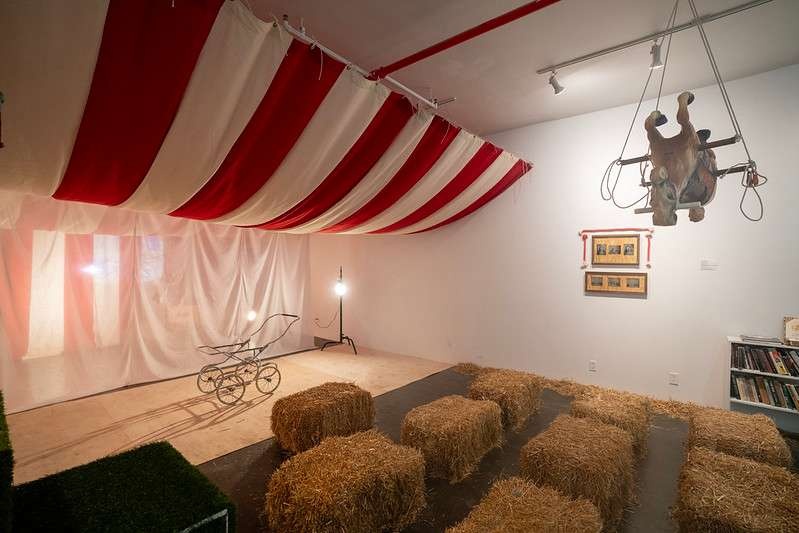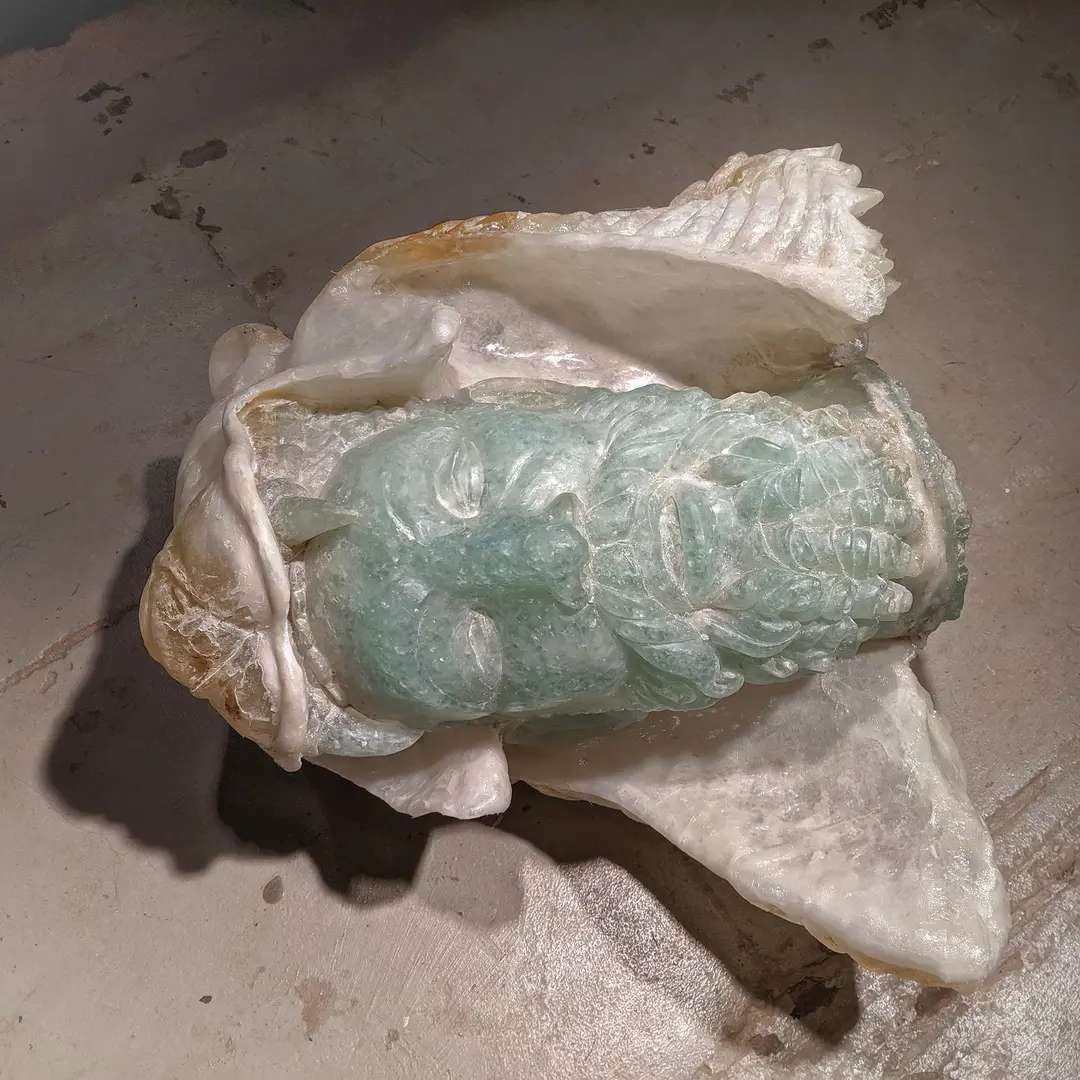Ilana Harris-Babou’s installations and videos critique our contemporary culture of self-improvement. This culture, however, is only the most recent chapter in a long history of domestic advice literature. Placing Harris-Babou’s work in dialogue with a mid-twentieth-century history of domestic advice helps us to see how entrenched are the biases she calls out, and for how many decades American popular culture has been mesmerized by the promise of infinite control over our private lives.
Here at Recess, Harris-Babou is mashing together a hardware store with home improvement (what tools will she make?) and design advice (are those decorative ashtrays on some of the shelves?). Yet this confabulation has appeared previously, in George Nelson and Henry Wright’s House of Tomorrow (1945). In House of Tomorrow, Nelson and Wright offer pages of elegant, austere mid-century modernist interiors—a few pieces of furniture dramatically placed on open expanses of floor, with large plate-glass windows behind—and then recommend studying the storage devices used in hardware stores to achieve that decorative effect: “Next time you go down to the corner drugstore, grocery, or delicatessen, look to see how your local merchant stores his wares,” they advise. “Just a few days ago, one of us went down to the local hardware store and talked to the owner…Everything fitted very comfortably on shelves not more than ten inches wide. Let us keep this fact in mind, because it is of the greatest importance in working out a really efficient storage scheme.”
To be sure, Nelson and Wright are not suggesting that your mid-century house should look exactly like a hardware store, even one as fascinating as Harris and Daughter Home Goods. Rather, they believe a “really efficient storage scheme” will enable the “severe” modernist interiors they illustrate in their book, as they lecture their readers: “If you have an adequate number of storage spaces, properly shaped and properly located, you can take care of everything that has to be kept out of sight and still have a good deal of space left over.” For Nelson and Wright, good storage is an excellent tool of control. It serves to inventory our personal lives, with all of the random objects we acquire as we follow fads and take on new responsibilities. It promises to organize our possessions—as idiosyncratic, damaged, and ugly as they may be—and then hide them away to create a model home appropriate for the scrutinizing eyes of guests and neighbors. After all, the storage device in itself is not the only tool of control—so too are the social standards by which we measure ourselves, the same social standards that govern advice literature and that percolate through Harris and Daughter Home Goods. It is significant that here in the gallery, on the open shelves, nothing is hidden away: we see the layers of history of Harris-Babou’s sculptural practice, arranged and rearranged and added to during the course of her residency at Recess.
Harris-Babou also merges DIY empowerment and cooking lessons, as did Mary and Russel Wright, whose Guide to Easier Living (1950) included everything from how to hang draperies to advice about one-dish dinners. The Guide to Easier Living promises the liberation of the efficiently managed home, with an empowered housewife learning to reduce her workload at every step. Yet the controlling eye of guests is an active presence in the narrative of self-improvement in this book as well. In a chapter on cooking and entertaining, the authors describe “The New Etiquette,” which is predicated on shared hosting work between wife and husband. This model is not without its pressures, however, as they remind their readers: “So, for the sake of smoothness and efficiency, decide ahead of time who is to carry in the main course, who is to carve, who is to fill plates, suggest second helpings…and so on and so on. After a while you’ll both get so expert at this kind of teamwork that you’ll even learn to follow each other’s improvisations when things don’t go as planned—like practiced dance partners.” Improvisation might be the ultimate counterpoint to control—it is the freeform act when parameters have fallen away—but here that moment of freedom comes under stage lights and the pressure of performance. It is always coopted by the controlling eyes of judgmental guests. Harris-Babou courts mistakes in her beautifully filmed cooking lessons, where immaculate sets are slowly compromised by strewn liquids and misbehaving appliances. But are her mistakes actually improvisations? Just like the Wrights’ carefully practiced dance partners, these deviations are ultimately scripted, and fully loaded with expectation, prepared to stand up under the gaze of critiquing eyes. Harris-Babou acknowledges the pervasive gaze of control, whereas Mary and Russel Wright prefer to give us the illusion we can escape it.
Advice literature—and the aspirational YouTube channels and Instagram feeds that now accompany the genre—is a phenomenon of the perpetual future. Authorities such as Nelson and Wright or the married Wrights ask us to continually plan for our future. To the extent that our discontent with the present day motivates us, we pay attention to it, but our energy is really focused on fantasizing about the next perfect party and planning the way our homes will look after we’ve organized them. With so much focus on the future, it is the reader’s privilege to forget the past and ignore what may have brought her to the unsatisfactory present. Harris-Babou’s art illuminates the relentless control that undergirds these aspirational texts. More importantly, it calls out the historical amnesia that pervades them by constantly referring to the past-ness of things. Her tools in the hardware store have a tangible history: we can see the marks of the moldings from which they were cast, and we can see the evidence of her handicraft in their formation. These are objects that constitute the history of her artistic practice. Moreover, the storage shelves have been painted dark to “look old,” in her words. They remind us that it is a privilege to rewrite the past in aesthetically appropriate forms, or, more radically, to forget the past altogether. Their faux-age and open shelves full of personal history ask us to consider the many ways that history and private lives should not be controlled.
About the artist
Kristina Wilson
Kristina Wilson is Professor of Art History at Clark University. Read more about her work at https://wordpress.clarku.edu/krwilson/.
Projects
Explore/Archive
See allOctober 2025
streamlined reflections, courtesy of noise canceling headphones
Gabrielle Rucker
Gabrielle Rucker reflects on the radical intimacy and auditory life at the heart of Deli Radio
July 2025
Tell My Jockey: CUNTRY’s Discourse From the Horse’s Mouth
Ericka Pérez
Assembly fellow Ericka Pérez reflects on clowning, resistance, and CUNTRY’s radical refusal to perform.
April 2025
The Second Head of Hercules: Art and Resistance Through Four Years of Upheaval
Shakeem Floyd
written in conjunction with artist Onyedike Chuke's Session x Assembly project, The Forever Museum Archive: Circa 2020_An Object





